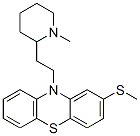-
Name
Thioridazine
- EINECS 200-044-2
- CAS No. 50-52-2
- Article Data12
- CAS DataBase
- Density 1.237 g/cm3
- Solubility 1.113mg/L(22.5 oC)
- Melting Point 72-74°
- Formula C21H26N2S2
- Boiling Point 515.665 °C at 760 mmHg
- Molecular Weight 370.583
- Flash Point 265.665 °C
- Transport Information
- Appearance
- Safety 16-36/37-45-61
- Risk Codes 11-23/24/25-39/23/24/25-52/53
-
Molecular Structure
- Hazard Symbols F,T
- Synonyms Phenothiazine,10-[2-(1-methyl-2-piperidyl)ethyl]-2-(methylthio)- (6CI,8CI);10-[2-(1-Methyl-2-piperidyl)ethyl]-2-(methylthio)phenothiazine;2-Methylmercapto-10-[2-N-methyl-2-piperidyl)ethyl]phenothiazine;Sonapax;Thioridazine prolongatum;dl-Thioridazine;
- PSA 57.08000
- LogP 5.88850
Thioridazine Chemical Properties
Chemical Name: Thioridazine
IUPAC NAME: 10-[2-(1-Methylpiperidin-2-yl)ethyl]-2-methylsulfanylphenothiazine
CAS No.: 50-52-2
EINECS: 200-044-2
Molecular Formula: C21H26N2S2
Molecular Weight: 370.57 g/mol
Density: 1.23 g/cm3
Flash Point: 265.7 °C
Boiling Point: 515.7 °C at 760 mmHg
Following is the structure of 10-(2-(1-Methyl-2-piperidyl)ethyl)-2-(methylthio)phenothiazine (50-52-2):

Product Categories about 10-(2-(1-Methyl-2-piperidyl)ethyl)-2-(methylthio)phenothiazine (50-52-2) is mainly refer to Thioridazine
The chemical synonymous of 10-(2-(1-Methyl-2-piperidyl)ethyl)-2-(methylthio)phenothiazine (50-52-2) are Thioridazine;10-((1-Methyl-2-piperidyl)ethyl)-2-(methylthio)-phenothiazin;10-(2-(1-Methyl-2-piperidinyl)ethyl)-2-(methylthio)-10H-phenothiazin;10-(2-(1-Methyl-2-piperidyl)ethyl)-2-(methylthio)phenothiazine;10-[2-(1-Methyl-2-piperidinyl)ethyl]-2-(methylsulfanyl)-10H-phenothiazine;10h-Phenothiazine, 10-[2-(1-Methyl-2-piperidinyl)ethyl]-2-(methylthio)-
Thioridazine Toxicity Data With Reference
| 1. | sln-dmg-orl 100 mg/L | IJEBA6 Indian Journal of Experimental Biology. 11 (1973),403. | ||
| 2. | orl-cld TDLo:28 mg/kg/2W-I | AJPSAO American Journal of Psychiatry. 143 (1985),1176. | ||
| 3. | orl-cld TDLo:28 mg/kg/2W-I:BAH | AJPSAO American Journal of Psychiatry. 143 (1985),1176. | ||
| 4. | orl-wmn TDLo:14,500 mg/kg/15Y-I:EYE | CMAJAX Canadian Medical Association Journal. 132 (1985),737. | ||
| 5. | orl-hmn LDLo:43 mg/kg | ARGPAQ Archives of General Psychiatry. 34 (1977),955. | ||
| 6. | orl-chd TDLo:25 mg/kg:CNS,CVS | AJDCAI American Journal of Diseases of Children. 130 (1976),507. | ||
| 7. | orl-hmn TDLo:24 mg/kg:ANS AACRAT 52,938,73 | |||
| 8. | orl-rat LD50:995 mg/kg | TXAPA9 Toxicology and Applied Pharmacology. 18 (1971),185. | ||
| 9. | ipr-rat LD50:150 mg/kg | PCJOAU Pharmaceutical Chemistry Journal (English Translation). Translation of KHFZAN. 10 (1976),1001. | ||
| 10. | scu-rat LD50:640 mg/kg | MDCHAG Medicinal Chemistry: A Series of Monographs. 4 (1967),199. | ||
|
|
Thioridazine Consensus Reports
EPA Genetic Toxicology Program.
Thioridazine Safety Profile
Human poison by ingestion. Experimental poison by ingestion, subcutaneous, and intraperitoneal routes. Human systemic effects by ingestion: heart rate change, muscle contraction or spasticity, parasympatholytic, toxic psychosis, visual field and retinal changes. Human reproductive effects. Experimental reproductive effects. Mutation data reported. An antipsychotic and sedative. When heated to decomposition it emits very toxic fumes of NOx and SOx.
Related Products
- Thioridazine
- Thioridazine hydrochloride
- 505-22-6
- 505-23-7
- 50526-52-8
- 50528-73-9
- 50528-80-8
- 50528-86-4
- 505-29-3
- 50529-33-4
- 50530-12-6
- 50530-43-3
Hot Products
About|Contact|Cas|Product Name|Molecular|Country|Encyclopedia
Message|New Cas|MSDS|Service|Advertisement|CAS DataBase|Article Data|Manufacturers | Chemical Catalog
©2008 LookChem.com,License: ICP
NO.:Zhejiang16009103
complaints:service@lookchem.com Desktop View